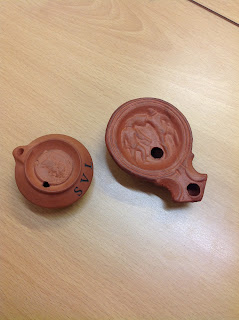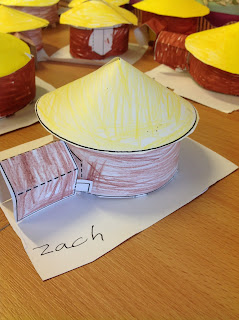We had an exciting afternoon in 3V following in the footsteps of Archaeologists from the University of Wales and the Gloucester Life Museum as we investigated a real life 'History Mystery.'
A few years ago, Archaeologists discovered the remains of an ancient building in a farmer's field in one of the most westerly points of Wales. Geophysical surveys revealed the outline of a number of rooms, and preliminary digging showed the remnants of ancient stones. The remains looked very much like those of a Roman villa - but, at that time, historians did not believe that the Romans had ventured so far to the west of Wales. It was a bit of a mystery!
Digging deeper, the Archaeologists found a number of artefacts on the site. Could these be Roman remains? Or were they merely the remains of a Celtic village?
 |
| The Geophysical Survey (which works a bit like an X-Ray for the ground) revealed the outline of an ancient building |
The children knew that the Celts tended to build roundhouses with wooden frames, which were usually clustered together in small groups - so these rectangular remains did not fit the description. Could it really be a Roman villa instead?
We watched a short video showing a reconstruction of a Roman villa to find out what a Roman villa might have looked like (you can watch it here:
Roman Villa Reconstruction).
As we watched, we were careful to think about the kinds of things that might have survived for nearly 2000 years under the ground. This led to some interesting discussions!
Mrs Vaqueiro then explained that artefacts that had been retrieved from the site were now on display in a museum, but that the museum had been kind enough to lend some of these precious items to us, so that we could examine them closely, and try to find out more about the people who lived or worked in the ancient building.
Each table group had a selection of artefacts to look at. Some of them were quite mysterious, and the children handled them very sensibly as they tried to work out what they were, and how they might have been used.
 |
| What could this mysterious fragment be? |
 |
| The children were able to handle real Roman artefacts and try to work out how they had been used. This piece of Roman pottery had a curious metal staple through it - why? |
 |
| This metal item jingled and rattled when shaken: could it have been a child's toy? Or could it have been used in a Roman temple? |
 |
| There were many theories about this big slab of terracotta. It had an interesting pattern on one side. |
 |
| The children thought this artefact smelt strongly of crayons. They had some interesting theories about why there was a small piece of string inside it too. |
 |
| This artefact had a decorative motif that looked a lot like some of the Roman coins. The children wondered if it was what the Romans had used to make their coins. |
 |
| The sandals were quite obvious, but with feet that size, who might they have belonged to? Why did they need the metal studs in the soles? |
 |
| These wooden blocks had wax tablets inside, and they were accompanied by a metal stylus. The children surmised that the Romans used them for jotting messages - but why didn't they just use paper and pen? |
 |
| These tiny tiles fitted together to make a pattern. How might they have been used in the Roman house? |
 |
| The coins had plenty of clues: we looked for the names and portraits of Roman Emperors, and also tried to see if we could find any dates to help us decide how old they might be. |
Once they had had a good look at the items, the children reported back on their findings to the rest of the class, taking questions from the audience. Their discussions were very thoughtful and mature, and there were some very carefully considered suggestions about some of the more mysterious items.
We finished the lesson by asking ourselves what we had learnt about the occupants of the building, just by looking at the things they had left behind. We also considered the things that the artefacts can't tell us: we don't know what the people looked like, or how many of them lived there, or whether they were good or kind people. Artefacts can help us learn a lot about some aspects of history, but they will not always tell us everything.
Mrs Vaqueiro
















































